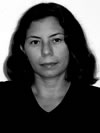Lectures and Talks, HAU 3: April 15, 5.30 pm – 7.30 pm
Belém do Pará, Fortaleza, Porto Alegre: a Different Way of Dancing?
presentation: Susanne Foellmer
Every region in Brazil has its own characteristics. They are derived from particular cultural, political, social and economic contexts, which must be taken into consideration when regarding contemporary dance. The differences and similarities in dance in these three Brazilian cities will be the subject of discussion.
 Dance
at the Universidade Federal do Pará: A Unique Path:
Dance
at the Universidade Federal do Pará: A Unique Path:
Waldete Brito (Belém) – MA in Scenic Arts at
the UFBA, lecturer at the Escola de Teatro e Dança (School
for Theater and Dance) at the UFPA, coordinator of the courses
for dance technicians, theater and choreography. Ballerina,
choreographer, artistic director of the company Experimental
de Dança. Former teacher and choreographer of the Grupo
Coreográfico da UFPA. Initiator of the project Estudo
e Criação em Dança Contemporânea
(Studies and Creation in Contemporary Dance).
The city of Belém in the state of Pará to the North of Brazil experienced
in 1964 – just like the other states – the effects of the miltary
coup. In spite of censorship, artists and cultural activists found paths of resistance.
In cooperation with the Ministry for Ediucation and Culture, the UFPA offered
the first course on modern dance for the citizens of Pará on initiative
of Eni Corrêa. In 1968, the first dance group in an academic context was
founded: Grupo Coreográfico da UFPA (UFPA Choreographic Group) - Center
for Training and Research in Contemporary Dance. With its innovative and avant-gardistic
work, it contributed to the introduction of the first course on dance technique
in northern Brazil at the UFPA. From 2008, the university will also be offering
a certified diploma course for dance. This talk takes a look at how dance historically
and aesthetically found its way into the university with an eye on its relationship
to knowledge and skill in the artistic-academic field.
 Alpendre
from Within and Without:
Alpendre
from Within and Without:
Andrea Bardawil (Fortaleza) – Choreographer, since 1991
director of the Compagnie Arte Andanças, contributor
to the project Rumos Itaú Cultural Dança, scholarship
from the Bolsa Vitae Art Program in 2000. In 2003 she was artistic
director at the Dance College of Ceará. She is currently
coordinator of the Núcleo de Dança do ALPENDRE
(Art House for Research and Publication), of dance technique
courses (Senac, Secult e Centro Cultural Dragão do Mar)
and the Ceará International Dance Biennale.
The experiences of the past seven years of working in Alpendre have opened up
room for a very special dialogue between dance and other artistic languages and
have encouraged an intense and fruitful exchange of contemporary research. In
addition to artistic production, this has produced a knowledge base that in itself
opens up fresh frontiers for new developments. The study and practice of dance
in Alpendre, initiated by the Compagnie Cia. da Arte Andanças, reflects
the diversity and vitality of scenic dance in Ceará over the last ten
years. This development has much to do with the support of the Bienal Internacional
de Dança (International Dance Biennale), the Instituto Dragão do
Mar (Ceará Dance College) and other initiatives. I would like to will
speak about some of the particularities of this process, focusing thereby on
this space as a new field of possibility in the city, an in-between place, always
open for experimentation.
 Dance
in Southern Brazil: The Clash of Tradition and the Contemporary,
of the Sublime and the Popular:
Dance
in Southern Brazil: The Clash of Tradition and the Contemporary,
of the Sublime and the Popular:
Airton Tomazzoni (Porto Alegre) - Journalist, choreographer
and scholar. MA in Communication Studies at the Unisinos. Professor
for Dance at the UFRGS. Director of the municipal dance center
in Porto Alegre’s Department for Culture.
Dance production in Porto Alegre has a long-standing tradition. On the one hand
there is the strong cultural influence of the folklore of the south-Brazilian
cowboys – the gaúcho – affected by rural life and the fighting
and butchering of cattle. On the other hand lies the pioneer spirit of artistic
creation in dance, which emerged with the Instituto de Cultura Física
(Institute for Physical Culture). The Instituto trained the first professional
dancers in Dalcroze gymnastics and soon after, beginning of the 20th century,
brought classical ballet to Rio Grande do Sul. Throughout the sublime and the
popular always existed side-by-side and often clashed. The contemporary scene
changed this and introduced a new approach by which these previously independent
directions in dance were given the chance to present themselves, began to intermingle
and foster unique relationships – a development that today reveals its
unique quality in current productions.

